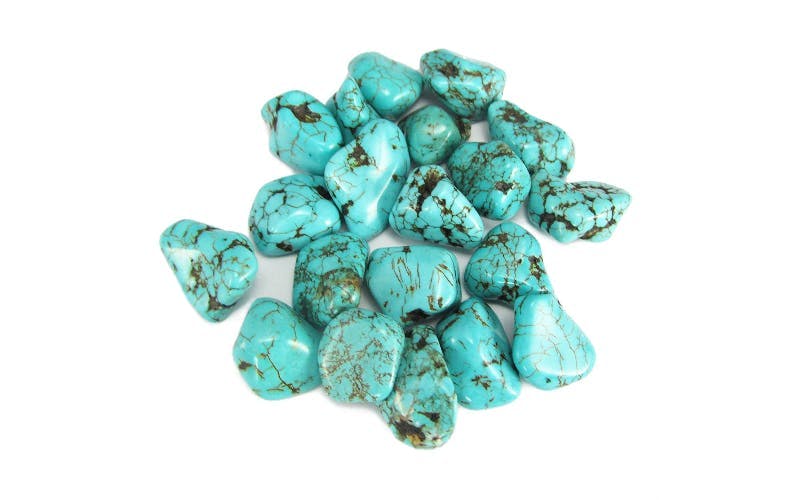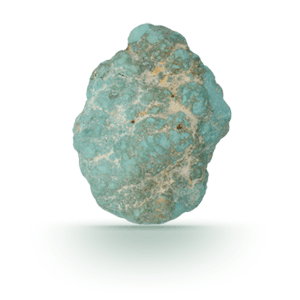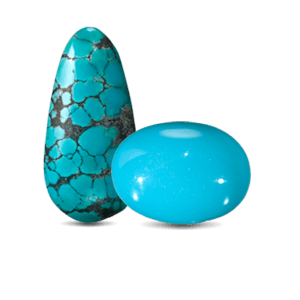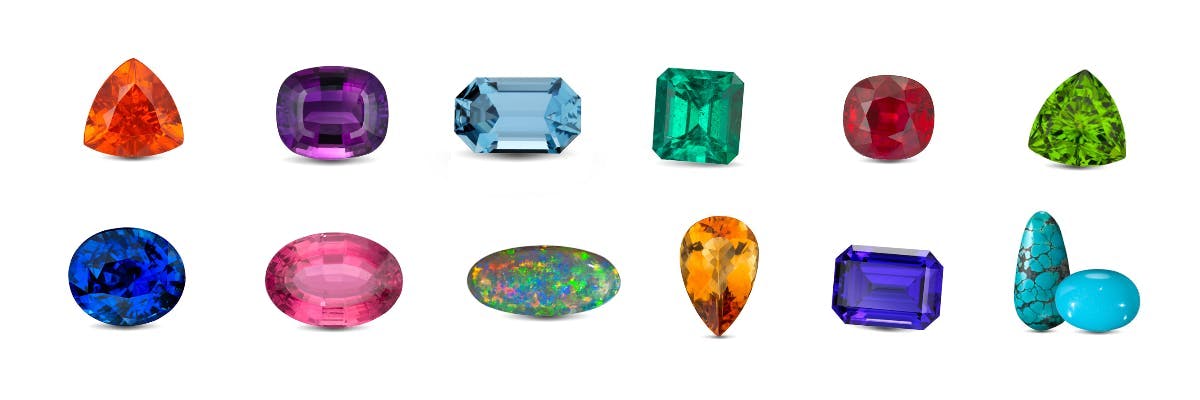Learn About Turquoise


Turquoise is found in only a few places on earth: dry and barren regions where acidic, copper-rich groundwater seeps downward and reacts with minerals that contain phosphorus and aluminum. The result of this sedimentary process is a porous, semitranslucent to opaque compound of hydrated copper and aluminum phosphate.
Turquoise Birthstones & Anniversaries
Turquoise is the traditional birthstone for the month of December and the gem of the 11th anniversary.

Rough Turquoise

Polished Turquoise
Overview of Turquoise
Admired since ancient times, turquoise is known for its distinct color, which ranges from powdery blue to greenish robin egg blue. It’s one of few minerals to lend its name to anything that resembles its striking color.
The word “turquoise” dates back to the 13th century, drawing from the French expression pierre tourques, which referenced the “Turkish stone” brought to Europe from Turkey.
Ancient Persia (now Iran) was the traditional source for sky blue turquoise gemstones. This color is often called “Persian blue” today, regardless of its origin. The Sinai Peninsula in Egypt was also an important historical source of turquoise gems.
The U.S. is now the world’s largest turquoise supplier. Nevada, New Mexico, California, and Colorado have produced turquoise, but Arizona leads in production by value, as well as quality. The stone’s popularity here makes it a staple in Native American jewelry.
Turquoise is found in arid regions where rainwater dissolves copper in the soil, forming colorful nodular deposits when it combines with aluminum and phosphorus. Copper contributes blue hues, while iron and chrome add a hint of green.
Some turquoise contains pieces of host rock, called matrix, which appear as dark webs or patches in the material. This can lower the stone’s value, although the uniform “spiderweb” pattern of Southwestern turquoise is attractive.
Turquoise is sensitive to direct sunlight and solvents like makeup, perfume, and natural oils. The hardest turquoise only measures 6 on the Mohs scale, which made this soft gemstone popular in carved talismans throughout history.
From ancient Egyptians to Persians, Aztecs and Native Americans, kings and warriors alike admired turquoise for thousands of years. It adorned everything from jewelry to ceremonial masks to weapons and bridles.
Highly esteemed for its striking namesake color and its ancient history, turquoise’s popularity remains timeless.
History of Turquoise
Since ancient times, cultures around the world have admired the distinct color of turquoise.
The earliest evidence of turquoise gemstones comes from ancient Egyptian tombs, which contain elaborate turquoise jewelry dating back to 3000 BCE. Egyptians set turquoise in gold necklaces and rings, used it as inlay, and carved it into scarabs. Most notably, King Tut’s iconic burial mask was extravagantly adorned with turquoise.
The oldest turquoise mines are in the Sinai Peninsula of Egypt. One sat near an ancient temple dedicated to Hathor, the Greek goddess of love and joy who was worshiped as a protector in the desert and as the patron saint of mining. Egyptians called turquoise mefkat, which meant “joy” and “delight.”
Ancient Persians decorated extensively with turquoise, often engraving it with Arabic script. Turquoise covered palace domes because its sky-blue color represented heaven. This later inspired the use of turquoise in buildings like the Taj Mahal.
Believing turquoise guaranteed protection, Persians adorned their daggers and horses’ bridles with it. Their name for turquoise, pirouzeh, meant “victory.”
Persians wore turquoise gemstone jewelry around their necks and in their turbans. They believed it offered protection by changing color to warn of pending doom. (Turquoise can, in fact, fade if exposed to sunlight or solvents.)
When Turkish traders introduced this “Persian blue” stone to Europe via the Silk Road in the 13th century, they influenced the gemstone’s name. The word “turquoise” comes from the French pierre tourques for “Turkish stone.”
Meanwhile, pre-Columbian Native Americans mined the turquoise stone throughout the present-day southwestern United States. Shamans used it in sacred ceremonies to commune with the spirit of the sky.
Apache Indians believed that attaching turquoise to bows (and later, firearms) improved a hunter’s accuracy.
Turquoise became valuable in Native American trade, which carried North American material toward South America. Consequently, Aztecs cherished turquoise for its protective power and used it on ceremonial masks, knives, and shields.
The turquoise-studded silver jewelry that’s commonly associated with Native Americans today originated in the 1880s, when a white trader convinced a Navajo craftsman to transform a silver coin into turquoise jewelry.
While many historic turquoise deposits have depleted over the gemstone’s long lifetime, some small mine operations (mainly in the U.S.) still produce fine material today.
Frequently asked questions about Turquoise
Gemstone Guide
Learn more about colorful gemstones, their symbolism, which stone represents your birthstone, which stone to celebrate an Anniversary with and more ways to incorporate colorful gems in to your jewelry box.


Visit us in any Lee Michaels Fine Jewelry location to browse a more robust assortment of turquoise earrings, turquoise necklaces, turquoise bracelets, David Yurman turquoise jewelry and many more. Shop more jewelry trends at any Lee Michaels Fine Jewelry store near you. In Baton Rouge, Louisiana, a Lee Michaels Fine Jewelry store is located inside the Mall of Louisiana and there is also a Lee Michaels Fine Jewelry store located at the corner of Corporate Boulevard and Jefferson Highway near mid-city. In Lafayette, Louisiana, a Lee Michaels Fine Jewelry store is located on Ambassador Caffery. In Shreveport, Louisiana, a Lee Michaels Fine Jewelry store is located on Youree Drive at East 70th. Just outside of New Orleans, Louisiana, in Metairie, a Lee Michaels Fine Jewelry store is located on Causeway Boulevard at Lakeside Shopping Center. In San Antonio, Texas there are two Lee Michaels Fine Jewelry stores. Find one at The Shops at La Cantera and another located inside the Northstar Mall on San Pedro Avenue. In Jackson, Mississippi, visit a Lee Michaels Fine Jewelry store located at the Renaissance at Colony Park on Highland Colony Parkway. Visit the newest Lee Michaels Fine Jewelry store, located in ABQ Uptown of Albuquerque, New Mexico.
